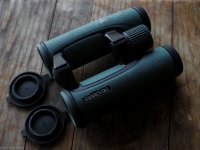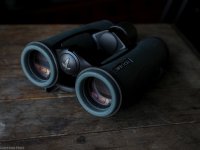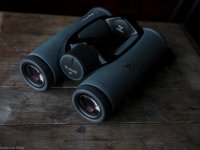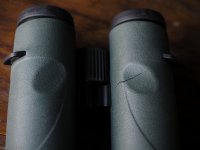WOW - I would be VERY upset! I have a pair of 3yr old EL32s and 1.5yr old NL32s and have never had an issue with the rubber.Photos of ELs belonging to me and other birders locally
-
Welcome to BirdForum, the internet's largest birding community with thousands of members from all over the world. The forums are dedicated to wild birds, birding, binoculars and equipment and all that goes with it.
Please register for an account to take part in the discussions in the forum, post your pictures in the gallery and more.
You are using an out of date browser. It may not display this or other websites correctly.
You should upgrade or use an alternative browser.
You should upgrade or use an alternative browser.
Poll - Trying to get some numbers on Swarovski rubber armour issues. (2 Viewers)
More options
Who Replied?dorubird
The unskilled mechanic blames his tools!

What catches our attention is the fact that the binoculars look flawless, which is very normal because it was used with care and attention. It practically looks like new out of the box!



But the only exception is that big crack!!! This exception confirms that it is an engineering design problem and not due to improper and abusive use by the owners! And when you put our hand on binoculars, we notice that it is sticky everywhere there is rubber (armor, eyecup rubbers, lens caps)




But the only exception is that big crack!!! This exception confirms that it is an engineering design problem and not due to improper and abusive use by the owners! And when you put our hand on binoculars, we notice that it is sticky everywhere there is rubber (armor, eyecup rubbers, lens caps)

Last edited:
MiddleRiver
Well-known member

In the world of sustainable design, there is a term and concept know as ‘cradle-to-cradle’. It makes no sense to promote ‘green’ solutions that in that CtoC analysis create other environmentally costly consequences. I have to assume that Swarovski tried a new formulation (and I applaud them for that) which they’re urgently trying to ‘fix’. It does sound like a PR failure in their not just dealing with it a little more transparently ;-)
Bramberg
Active member
Wow, that's pretty extreme degradation. I know that there is a lot of products that can cause this to rubberized materials, such as sunscreen, gun oil, deodorants and many more. Do you use any product that gets on your hands and then later ends up on your binoculars perhaps?Photos of ELs belonging to me and other birders locally
Swarovski have said that it's their environmentally friendly new armour material that's at fault, and are working on a new material.Wow, that's pretty extreme degradation. I know that there is a lot of products that can cause this to rubberized materials, such as sunscreen, gun oil, deodorants and many more. Do you use any product that gets on your hands and then later ends up on your binoculars perhaps?
Bramberg
Active member
Of course an armor should withstand all sorts of use and even a great deal of abuse. In this case it obviously doesn't. I was just thinking that there might be some products you could try to avoid getting on your binoculars to prolong the life of the armor. This is the reason that I asked.Swarovski have said that it's their environmentally friendly new armour material that's at fault, and are working on a new material.
Some people (me included) have no problem at all with deteriorating armor and some (like in your case) has severe degradation. Either the armor is different or the reason for severe degradation is an outside factor. The reason for the accellerated degradation could be acidic sweat, sunscreen, oils or other chemicals.
I have had this happen to the rubberized shoulder pad on some rifles. It's a somewhat common issue with some materials because the metal parts need something the keep rust away. This is usually some kind of oil, more typically synthetic oil. Even though it's a tiny amount that won't run it will still spread through the air from condensation. I fact, old clock makers and restorers actually used this effect to lube the internal mechanics by simply placing a little tray with oil on it inside the cleaned clockwork.
As mentioned; oils, petroleum products and other chemicals can certainly accelerate the degradation of rubberized materials. Even cooking oils do this. Some fabrics will gass off and can also cause this degradation.
I don't think there's an excuse to this happening to a supposedly top-quality product. But since it does happen, this might be something to consider.
Swarovski's own reply to another user, who posted in another thread here.Of course an armor should withstand all sorts of use and even a great deal of abuse. In this case it obviously doesn't. I was just thinking that there might be some products you could try to avoid getting on your binoculars to prolong the life of the armor. This is the reason that I asked.
Some people (me included) have no problem at all with deteriorating armor and some (like in your case) has severe degradation. Either the armor is different or the reason for severe degradation is an outside factor. The reason for the accellerated degradation could be acidic sweat, sunscreen, oils or other chemicals.
I have had this happen to the rubberized shoulder pad on some rifles. It's a somewhat common issue with some materials because the metal parts need something the keep rust away. This is usually some kind of oil, more typically synthetic oil. Even though it's a tiny amount that won't run it will still spread through the air from condensation. I fact, old clock makers and restorers actually used this effect to lube the internal mechanics by simply placing a little tray with oil on it inside the cleaned clockwork.
As mentioned; oils, petroleum products and other chemicals can certainly accelerate the degradation of rubberized materials. Even cooking oils do this. Some fabrics will gass off and can also cause this degradation.
I don't think there's an excuse to this happening to a supposedly top-quality product. But since it does happen, this might be something to consider.
It's not the chemicals, but environmental factors (temperature, UV, heat) that the material cannot withstand.
Swaro reply:
The armouring material of Swarovski binos was changed 2015 with the new FP series due to environmental, cosmetic and allergic reasons.
The new material is - on a long term perspective - biodegradable. The new NL armouring is made out of the same material.
In general the new material overall has a better resistance and performance (Temperature, UV, humidity, abrasion) than the old one of the SV, but if it deteriorates, its damage behavior differs from the older material - due to the biodegradability. The old material blisterd the new gets softer and softer until it tears.
Prolongation of the armouring is possible if you apply a good cleaning and treatment of it, like for instance for leather. For the rare case of deterioration we offer a free replacement.
Bramberg
Active member
Swarovski's own reply to another user, who posted in another thread here.
It's not the chemicals, but environmental factors (temperature, UV, heat) that the material cannot withstand.
Swarovski writes:
"Prolongation of the armouring is possible if you apply a good cleaning and treatment of it, like for instance for leather."
So there is probably some foreign substances that can accelerate the breakdown of the armor (since environmental factors such as temperature and UV light can't be cleaned off).
This would also explain why some binoculars don't show any signs of deterioration and some deteriorate quickly. Luckily, they say that they offer a free replacement in case of deterioration and from my own experience with them I don't doubt that they do.
Last edited:
Gary Schiltz
New member

More evidence of the phenomenon being discussed here, with my 8.5x42 EL. The rubber armoring has steadily disintegrated over the last couple of years. I could blame Ecuador's constant humidity to some extent, but not to this extent and not for binoculars that are made for birding. At first, the surface was just soft and sticky and yucky to hold, but now the armoring is severely cracked on one barrel and large patches of the material have fallen off, leaving sticky glue in its place. I hope Swarovski will re-armor them under warranty.
Attachments

I hope Swarovski will re-armor them under warranty.[/FONT]
They've been re-armouring all returns free of charge - so you'll be fine.
Wow, 38% of EL's and 20% of NL's is a large percentage for the sample size taken. Probably as the NL's are out in the field longer they will have more cracking.
Last edited:

Wow, 38% of EL's and 20% of NL's is a large percentage of the total binoculars produced. Probably as the NL's are out in the field longer they will have more cracking.
Out of respondents not out of binoculars produced - the figures are completely meaningless.
All you need is 100 samples to get a meaningful result from a survey. You don't need to survey all binoculars produced.Out of respondents not out of binoculars produced - the figures are completely meaningless.
"According to many statisticians, a sample size of 100 people is the minimum required for meaningful results in a survey."

How To Determine Survey Sample Size: A Short Guide
Understand how sample size affects survey confidence and why it's crucial for studies with large populations. Learn the importance of participant numbers.
I had to return my ELs three times but obviously in the stats was only recorded once!Out of respondents not out of binoculars produced - the figures are completely meaningless.
I am not buying any more Swarovskis until they get the armor issue fixed.I had to return my ELs three times but obviously in the stats was only recorded once!

All you need is 100 samples to get a meaningful result from a survey. You don't need to survey all binoculars produced.
"According to many statisticians, a sample size of 100 people is the minimum required for meaningful results in a survey."

How To Determine Survey Sample Size: A Short Guide
Understand how sample size affects survey confidence and why it's crucial for studies with large populations. Learn the importance of participant numbers.survicate.com
Statistics is a bit more complex than that
I am not buying any more Swarovskis until they get the armor issue fixed.
There have been reports that the armour has been reformulated - no idea what long term use will show.
Users who are viewing this thread
Total: 3 (members: 0, guests: 3)







